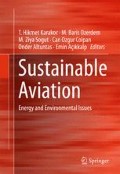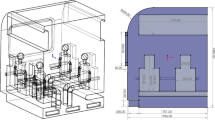Abstract
This paper gives an overview of what the airports and terminals at TAV Holding is doing as far as energy efficiency is concerned. The efforts at TAV consist of small incremental projects (addition of insulations, automatic door installation, performance improvements at cooling, heating, etc.) and big projects (Photovoltaic panels, Trigen, etc.). The building structure of the terminals is the main parameter in defining project outlines. Beside terminal structure, there are also other parameters that are affecting the energy performance of the building. By the cooperation with universities, thermal camera analyses had been carried out to detect the thermal insulation efficiency at the terminal shell. Customer satisfaction is the main parameter in terms of passenger comfort in terminal for aviation services. For this purpose, projects were carried out to decrease operational energy consumptions related to HVAC systems and thereby increase in passenger satisfaction. The most energy consuming system in terminals is the HVAC system with the percentage of 60 of the overall energy consumption. Thermal stratification system was implemented in a lounge area in one terminal. All projects had been analyzed for their payback period.
Similar content being viewed by others
Keywords
1 Introduction
Airports have a main role in transportation of people and goods at national and international boundary. Generally, airports are big areas with governmental and nongovernmental companies and entities including airlines, fuel supply units, terminal operators, catering companies, etc. Airports are similar to small towns in which many environmental issues are concerned. In recent years, the most important environmental issues is carbon management at airports. Carbon footprint management is directly related with energy and natural resource consumption. Therefore, energy and resource management is a critical point that needs special strategies in terms of environmental sustainability. On the other hand, energy and resource management gives the opportunity to decrease OPEX (operational expenditure) values.
Airport terminals are consuming high amounts of energy for lighting, heating, ventilation, air conditioning, and operational systems such as conveyance systems. The breakdown of energy consumption at terminal results in the highest energy consumption comes from HVAC systems. Therefore, many airport operators have focused on reducing operating expenses by focusing on energy efficiency , considering both energy supply and energy consumption. Airport operators. There are also renewable energy system applications of airports. Research is necessary to solve common operating problems, to adapt appropriate new technologies from other Industries to introduce innovations in the airport industry. Focus should be on increasing customer comfort, energy efficiency, and reducing operating costs at airport terminals. The main and simplest way is calculating payback period (in years) to determine the feasibility of energy efficiency projects.
More than two decades ago, the Bruntland Report identified buildings and energy efficiency as major areas to save the energy resources. Today, reports continue to echo the benefits and potentials of efficiency, including what could be described as its minimal environmental impact and ability to displace costly and disagreeable energy supplies, enhance security and prosperity, speed global development, and protect Earth’s climate not at cost but at a profit (ACRP Synthesis 21 2010).
As in Turkey’s airports, energy cost is 10–15 % of the total operating budget. Therefore, energy efficiency is identified as a high priority by respondents in current long-range plans.
2 Results and Discussion
The important point is to have normalized benchmarking energy efficiency values among airports. Normalization will enable airports to benchmark themselves without any further discussion.
There are different factors that are effecting airport energy consumption:
-
(a)
Airport size (area and volume of conditioned space, area of externally exposed building envelope)
-
(b)
Shape factors
-
Compact (one main building with bus transportation)
-
Pier finger terminals
-
Pier satellite terminals
-
Remote satellite terminals
-
-
(c)
Location-Climate (hot and cold degree days—HDD and CDD, solar radiation, and humidity levels)
-
(d)
Hours of operation
-
(e)
Building envelope
-
(f)
HVAC Systems and controls
-
(g)
Level of maintenance at the facility
-
(h)
Occupant/user behavior and energy management (Costa et al. 2012)
Several projects have been carried out in one pilot airport terminal in Turkey that are given in detail below.
2.1 Thermal Camera Analyses
Thermal camera is a thermographic camera that forms an image using infrared radiation, infrared cameras operate in wavelengths as long as 14,000 nm (14 µm).
After construction of the airport, thermal camera analyses have given a big opportunity to identify heat leaking areas at different point of the terminal as shown in Fig. 7.1a–c (Ekonomi Gazetecileri Derneği (EGD), V. Küresel Isınma Kurultayı, 2013).
According to the thermal camera analyses of one terminal, all isolation that need had been determined. Approximately 2 tons of isolation material (glass wool) had been used. Payback period has been calculated and given in Table 7.1.
As seen from Table 7.1, the payback period is low than 1 year by simple isolation works.
2.2 Solar Reflective Material
After construction of the terminal glass domes and light houses created big problems as they let the sun light to get in the terminal and resulted with a temperature increase inside the terminal. That also increased passenger complaints especially in summer.
A solar UV resistant reflective material has been covered on top of the glasses and domes from outside the terminal during the summer season (Fig. 7.2). It is been taken out during the winter season. The material has 87 % UV resistance.
This material has given a comfortable environment for passengers in the terminal. As seen in Table 7.2, the payback period is lower than 1 year for this project by which seasonal changes brings advantages to terminal heating and cooling operations.
2.3 Highspeed Doors
The gateway from the apron to the baggage handling system (BHS) area was being kept open previously. An automatic fast moving door has been installed to this entry (Fig. 7.3). Conventional automatic door linear speed was 0.5 m/s. The new type door that has been installed has a speed of 1.5 m/s. This resulted 6 °C temperature difference in baggage handling area.
These types of doors are now used at airports in Turkey. In Table 7.3, the payback period has been calculated for the high speed door usage. By this project, a comfortable environment has been obtained especially for staff working in BHS area.
2.4 Thermal Stratification
The use of ceiling (or floor) diffusers, (Fig. 7.4), that introduce air with some momentum alters the behavior in the lower zone by increasing the amount of mixing and changing the temperature profile. If the diffuser throw is close to the stratification height or already exceeds it, the throw will penetrate into the warm upper layer bringing warm air down into the lower region. The amount of air brought down influences the temperatures in the lower region. The amount of mixing in the lower layer influences the gradient. In the limit as throw and the amount of mixing is reduced, thermal stratification systems tend to approach the operation of displacement ventilation systems. Higher throws that penetrate above the stratification height will result in warmer temperatures and less gradient in the lower region, all other conditions being constant (Webster et al. 2002).
Thermal stratification has been implemented recently in one terminal lounge area. The area is approximately 2000 m3. In order to detect the expected homogen temperature profile, temperature sensors have been set at different heights in the area which are 1, 4, and 7 m. The most important issue is that temperature is a function of humidity and pressure. To obtain more detailed data, testing this system weather conditions (outdoor air temperature, relative humidity, pressure, solar radiation, wind speed, etc.) and inside conditions (temperature, humidity, pressure) should be tracked by inside and outside sensors.
While conventional HVAC systems cause drafts as a consequence of the high velocities of the incoming and outgoing air, distribution of air on the basis of the thermal stratification system basically ensures slow circulation of air at uniform air velocities of approx. 0.1 m/s throughout the entire room. The heating or cooling process is carried out by small ∆T increments. This uniform distribution also prevents local buildup of pollutants and reduces the levels of CO2 and volatile organic compounds. For this purpose, the quality of the air is measured continuously and introduction of fresh air is adjusted on the basis of the measured values. As seen in Fig. 7.5, airflow is more effective for thermal stratification system.
This project applied in the terminal has given a more comfortable environment in terms of heating and cooling. On the other hand approximately 30 % reduction in energy cost has been obtained. Payback period for this project is 2 years. Annual saving has been calculated as 19.000 TL with the investment of 38.000 TL for the lounge area in the terminal.
3 Conclusion
This paper gives a review of energy efficient applications at airports . Efficient energy management is an important concept in terms of carbon footprint and operational expenses. Carbon footprint is directly related with energy management strategies. By small efficient energy management projects approximately 30 % decrease can be obtained in energy consumption.
For airports, KPI, key performance index, normalization studies have to be carried out between energy consumption and operational data (flight numbers, passengers, baggage and freight movements, etc.). Normalization studies are very useful indicators for performance assessment and benchmarking.
References
ACRP Synthesis 21 (2010) Airport energy efficiency and cost reduction: a synthesis of airport practice. Transportation Research Board, Washington, D.C
Costa A, Blanes LM, Donnelly C, Keane MM (2012) Review of EU airport energy interests and priorities with respect to ICT, energy efficiency and enhanced building operation. In: Proceeding of the Twelfth International Conference for Enhanced Building Operations, Manchester, UK, 23–26 Oct 2012
Ekonomi Gazetecileri Derneği (EGD) (2013) V. Küresel Isınma Kurultayı, Enerjini Verimli Kullan, Geleceğine Sahip Çık p 61., May 2013, İstanbul, Turkey
Webster T, Bauman F, Reese J (2002) Underfloor air distribution: thermal stratification. ASHRAE J May 2002
Author information
Authors and Affiliations
Corresponding author
Editor information
Editors and Affiliations
Rights and permissions
Copyright information
© 2016 Springer International Publishing Switzerland
About this chapter
Cite this chapter
Büyükbay, M.N., Özdemir, G., Üstündağ, E. (2016). Sustainable Aviation Applications in Turkey: Energy Efficiency at Airport Terminals. In: Karakoc, T., Ozerdem, M., Sogut, M., Colpan, C., Altuntas, O., Açıkkalp, E. (eds) Sustainable Aviation. Springer, Cham. https://doi.org/10.1007/978-3-319-34181-1_7
Download citation
DOI: https://doi.org/10.1007/978-3-319-34181-1_7
Published:
Publisher Name: Springer, Cham
Print ISBN: 978-3-319-34179-8
Online ISBN: 978-3-319-34181-1
eBook Packages: EnergyEnergy (R0)









